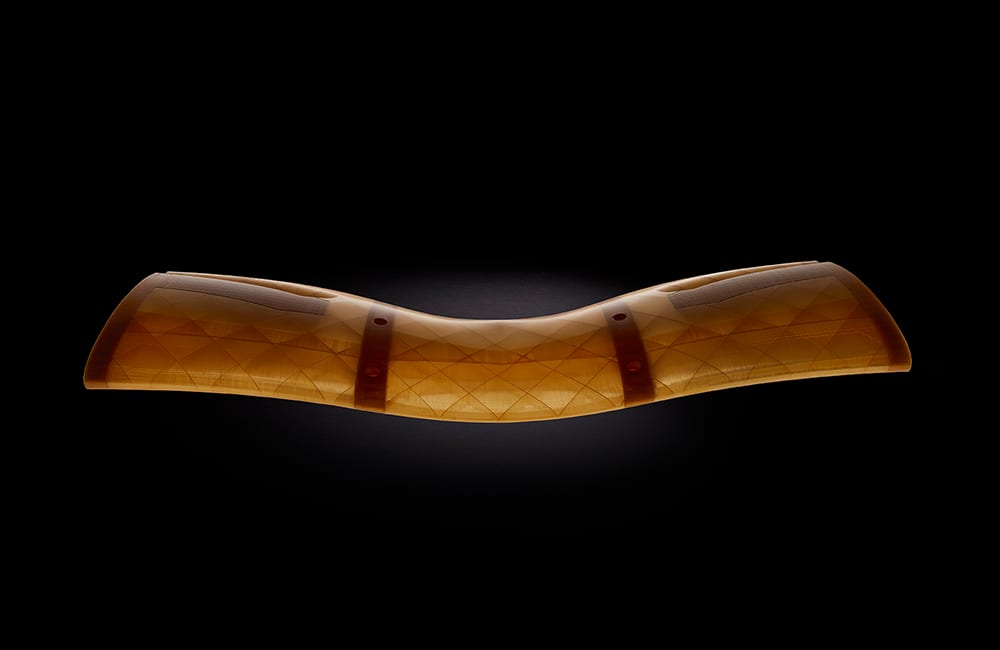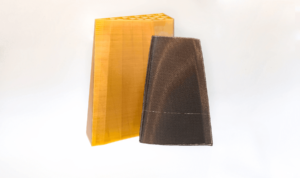

Previously published on fastradius.com on February 4, 2020
High-performance plastic polymers fall into two categories: thermosets and thermoplastics. Thermosetting polymers are those that solidify to an irreversible hardness after curing due to chemical bonds within the plastic. The polymer hardens in a cross-link pattern that prevents it from re-melting, even under extreme heat.
ULTEM®, the branded name for polyetherimide (PEI), is one of the few commercially available amorphous thermoplastic resins that retains its mechanical integrity at high temperatures. Initially developed by General Electric Plastics Division (now SABIC) in the early 1980s, ULTEM is a high-performance plastic that has been a staple of the manufacturing industry for over 35 years. This material is strong, chemical- and flame-resistant, easy to use, and able to withstand extremely high temperatures while retaining a set of stable electrical properties.
Often used in the production of circuit boards, eyeglasses, food preparation and sterilization equipment, and, perhaps most notably, aircraft parts, ULTEM is known for its strength and durability. Read on to find out everything you need to know about ULTEM.
ULTEM is easy to thermoform and can be manufactured using fused deposition modeling (FDM). A heated nozzle repeatedly follows a set toolpath and emits one layer of the material at a time until the product is fully formed.


Injection modeling is another quick and cost-effective option for manufacturing with ULTEM. Thermoplastic pellets are fed into the injection molding screw, melted and injected into the mold, cooled and hardened, then the completed part is pushed out via the ejector pin. This process is ideal for production of uniform parts in high quantities, such as burn-in sockets.
ULTEM stands out from other high-performance polymers because it is uniquely designed to remain mechanically stable under extreme conditions. It can withstand temperatures upwards of 217°C for extended periods of time and remain dimensionally stable in fluctuating temperatures. It is inherently flame resistant and produces minimal smoke that is no more toxic than smoke produced from burning wood.
Amorphous thermoplastics have the tendency to crack when they come into contact with fats and oils from food, alcohols, acids, fluids used for servicing cars and aircrafts, and other aqueous solutions. Not only can ULTEM resist stress cracking under such conditions, but it is also resistant to ultraviolet rays and gamma radiation.
ULTEM’s key mechanical specifications include:
These mechanical specifications are applicable only for standard ULTEM — specifications will vary for different varieties of the product, including ULTEM 10%, 20%, and 30% Glass Reinforced.
The aerospace industry is understandably strict with the mechanical standards and quality regulations to which parts must comply. To ensure compliance with the qualification and equivalency standards set out by the Federal Aviation Administration (FAA), new parts must go through long, rigorous, and expensive testing and approval processes.
Unfortunately, these lengthy processes are incompatible with the rising demand for newer, faster, and cheaper aircrafts. To meet this demand, industry leaders like Boeing and Airbus are expected to accelerate production times while keeping costs low. A growing number of players in the commercial aerospace industry are meeting these challenges head-on with the help of additive manufacturing — a process in which they can use ULTEM.
ULTEM is among the few resins approved for use in the commercial aerospace sector. It beats out comparable thermoplastics when it comes to resisting creep, the tendency of materials to deform and degrade under repeated mechanical stress. It also holds up well when brought into contact with various fuels, coolants, and lubricants. Its flame-resistance ensures that it meets FAA regulation 25.853 for flammability. In fact, ULTEM has already shown great promise as a viable material for fire blockers and airplane seat covers.
What’s more, ULTEM can help aircraft companies reach their cost-cutting goals by cutting weight. For example, LSG Sky Chefs and Norduyn collaborated on a fleet of ultra-light in-flight trolleys that leveraged ULTEM. A full Boeing 747 loaded with these trolleys would be 1,650 pounds lighter than a plane loaded with standard trolleys, a weight reduction that could generate around $65,000 in fuel savings per year. With ULTEM, aircraft part manufacturers don’t have to choose between a polymer that’s strong or lightweight — they get the best of both worlds.
For manufacturers, printing a product that’s strong, stable, lightweight, flame- and chemical-resistant, easy to process, and equipped with versatile mechanical properties might seem like a tall order. ULTEM checks every box. This high-fidelity polymer is a great choice for a variety of applications, from simple switches to complex airplane parts.
If you think ULTEM might be the right material for your next project, contact SyBridge today. We’re passionate about connecting innovative companies with the capabilities and technologies needed to bring their designs to life. Providing teams with unparalleled technical expertise, professional support, and a full suite of materials and production processes to produce virtually any part imaginable, SyBridge wants you to discover what’s possible.
Forget typical cycle times. We're pushing the boundaries of conformal cooling. While traditional approaches deliver…
Forget typical cycle times. We're pushing the boundaries of conformal cooling. While traditional approaches deliver…
From left to right: Brayden Janak (apprentice); Logan Vifaquain (CNC machining, Programming and CMM); Ron…
SyBridge Technologies is proud to announce we have been awarded the 2023 General Motors Supplier…
Today, designers and engineers are accustomed to working with digital tools in their day-to-day jobs.…
Optimizing Your Injection Molding Process for Cost-Effective Manufacturing Excellence In today’s competitive landscape, manufacturers are…